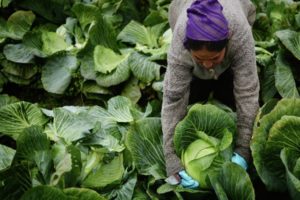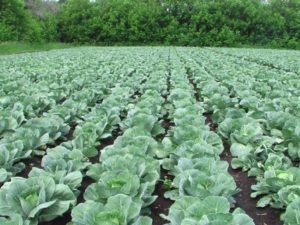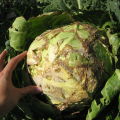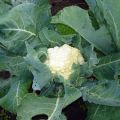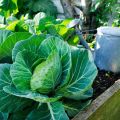How to grow and care for cabbage outdoors and in the greenhouse
Many gardeners prefer to grow cabbage outdoors and in greenhouses. It is much more difficult for beginners to grow healthy greens than for people who have been planting them for several years. To grow large heads of cabbage, you need to familiarize yourself with the video in advance, which shows how to care for cabbage in the garden. There are certain secrets of growing cabbage under the covering material and in the garden.
Sowing seeds
Before growing cabbage, you should know in advance how to grow seedlings correctly. There are different technologies for planting and germinating seeds.
To obtain cabbage seedlings, the seed must be planted at the end of winter, so that by the second half of spring it stretches well. However, cabbage planting in the Urals can be done a little earlier.
Seed preparation
Many vegetable growers ask themselves how to grow a good cabbage crop. To do this, you need to start preparing the planting material. This procedure will improve the germination of seedlings and help them to stretch better in the future. It also has a positive effect on productivity.
First, the seeds are disinfected, which protects the tomatoes from disease. To do this, all seeds should be removed in small bags and placed in several large containers with manganese solution. We soak them for 20 minutes, after which we open the bags and rinse the seeds with water.
Soil preparation
Before growing cabbage seedlings, you should start preparing the soil. To do this, you need to find out what cabbage loves and what components to add to the soil. When growing, cabbage seedlings should be in soils with a lot of nutrients.

It is recommended to use a soil with ash, as the seedlings stretch better in it. Also, ash can protect seedlings from the appearance of certain diseases.
Planting and growing
Having finished with the soil and seeds, you should familiarize yourself with the features of planting seeds and study the rules for growing seedlings. This will help you understand how to get a good harvest of cabbage. For plant germination, it is recommended to use cassettes that simplify the care of the seedlings.
Before planting seeds, the soil should be slightly watered. Then small holes are made in the ground, in which the seeds are placed. The next day, the cassettes with plants should be transferred to a warm room. However, before that, you need to find out what temperature the seedlings withstand in order to determine the best temperature regime.
It is not recommended to grow cabbage on the balcony, as young plants may not cope with temperature extremes.Cabbage loves light, so there is no need to hide it from the sun during cultivation.
Not everyone knows how many days seedlings should grow. Two months is enough to obtain healthy grown seedlings.
Planting seedlings
Transplanting cabbage into open ground should be carried out in June or in the last days of May. By this time, all the seeds will sprout and have time to germinate well.
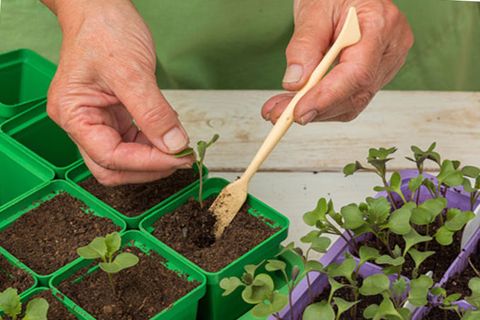
Site selection
Cultivation of cabbage outdoors under arches should be carried out in a suitable area.
First you need to figure out if it can be grown next to tomatoes and what can be planted next to cabbage. She has rather poor compatibility with other plants and therefore it is recommended to choose a secluded place for planting. However, if this is not possible, then the best neighbors in the garden are onions or garlic. It is recommended that there is a lot of sun on the site. It is the lighted areas that are the place where everything grows well.
Soil preparation
A properly prepared site will help to get a good cabbage. It should be prepared in the fall. We transplant tomatoes only into clay or sandy soil so that the seedlings stretch out better.
Care must be taken to ensure that the seedlings grow in fertilized soil. It is recommended to add lime and other mineral dressings to the site in advance. With the help of liming the soil and proper feeding, you can achieve a good harvest. Lime is also used if the acidity of the soil is too high to restore and stabilize its level.
Landing
Before you start studying the agricultural technology of growing cabbage, you need to know the features of planting seedlings. The first thing to do is create rows. Then holes are made on the marked rows. The size of each of them should be slightly larger than the size of the plant roots. The distance between the tomatoes should be at least 50-60 cm, so we make the holes at the same distance from each other. When all the holes are made, germinated seedlings are pulled out of the cassettes.
After that, we plant the seedlings in the ground and sprinkle them with a small layer of earth. After planting all the plants, the soil must be watered with warm water and compacted.
Care
After planting in open ground, you need to take care of the care of the planted bushes. After all, it is cabbage care that largely affects the quantity and quality of the harvest.
Watering
The main reason why the bushes grow slowly is improper watering of the plants. Therefore, outdoor care should include regular wetting of the area. It is recommended to water cabbage bushes quite often. However, this does not mean that you need to fill in with water and flood each bush. Flooded plants will slow down as large amounts of moisture can damage the roots. Therefore, you need to make sure that the bushes are not flooded.
Bushes germinate much faster with systematic watering every 2-4 days during the week. At the same time, no more than six liters of water should be spent per square meter of the site. Over time, the amount of moisture should be reduced and therefore the plants will only need to be watered once a week.

It is recommended to do abundant watering in the first half of summer, when the temperature rises sharply outside. Also, the watering of cabbage in a polycarbonate greenhouse is becoming more frequent, since the greenhouse room also gets very hot.
For watering, it is recommended to use a warm liquid that is heated to 20 degrees.
Top dressing
White cabbage planted in a greenhouse, loggias or open field needs periodic feeding, which helps to restore the amount of nutrients in the soil.
Before starting fertilization, it is necessary to build up the green mass. Therefore, the plants begin to feed only one and a half months after planting. For the first feeding, the Effekton preparation is perfect.To obtain the required solution, you will have to mix 100 ml of the drug with 10 liters of water. For each bush, no more than 500 ml of the prepared mixture is consumed.
The next feeding should be done when the plant is well stretched. In this case, you need to use a completely different mixture. To prepare it, half a liter of mullein should be diluted in 5 liters of water. You can also add a little Kemir to the liquid. Each cabbage bush is watered with a liter of solution.
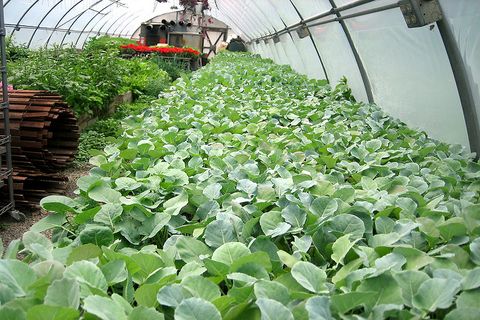
The third stage of fertilization is carried out in the second half of June. During this period, the bushes begin to form fruits and therefore the plant needs mineral fertilizers. To create a working mixture, mix 120 g of superphosphate with potassium sulfate and 5-7 liters of water. Then the mixture should be infused for 2-4 hours.
The last time fertilizers are applied to the soil at the end of summer. For this, a mixture prepared from 8 liters of water and 80 g of nitrophoska is used.
Treatment
Caring for cabbage after planting should include handling. Indeed, without this, she will not withstand some diseases and will begin to dry out.
Insects are the spread of many diseases, so it is necessary to protect seedlings from them. In the first weeks of growing, the bushes are covered with tobacco dust and ash. This treatment will protect them from fleas and slugs.
It is not recommended to use various chemicals during processing, since cabbage is a food product. The use of such funds can negatively affect the fruits. There are many other ways to protect plants. For example, you can get rid of aphids with tomato tops. To do this, it should be infused in water for two hours and boiled for the same amount. Then the liquid is cooled down, filtered and diluted with cold water.
You can also use onion husks, which are effective against caterpillars on cabbage stumps. Making an onion solution is pretty simple. For this, the jar with the husk is poured with warm water and infused for 2-3 days. Then the mixture is filtered and mixed with two liters of water.
Harvesting and storage
Some growers do not know when to remove cabbage from the garden. It is recommended to do this in autumn, after the first night frosts appear. Do not pick the fruit too late, as due to the night temperature, the heads of cabbage will begin to freeze and this will negatively affect the duration of their storage.
To get rid of the bushes, you will have to dig them up along with your roots. They are then sorted to get rid of small and spoiled heads that are best eaten right away. After that, the harvested crop must be prepared for further storage. To do this, stumps are cut off from all bushes a few centimeters below the location of the head of cabbage. When all the bushes are cut, the heads are placed in the cellar. It is he who is the most suitable place for storage. Most cellars have a high level of humidity and freezing temperatures. These conditions are ideal for cabbage heads.
The cellar must have a good ventilation system. If it is absent, then you will have to independently air the room.
It is not recommended to store cabbage outdoors, even temporarily. The fact is that in autumn, unstable weather and heads of cabbage can suffer after hail or other serious precipitation.
Conclusion
Anyone can grow and care for cabbage in the open field. To do this, you must familiarize yourself in advance with the peculiarities of growing and caring for cabbage. You can also watch the video, which describes in detail the care of cabbage seedlings and tells you when to remove cabbage from the garden.
